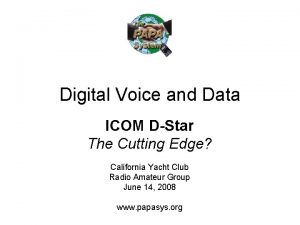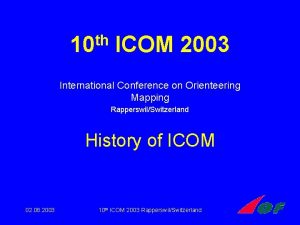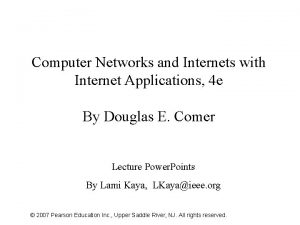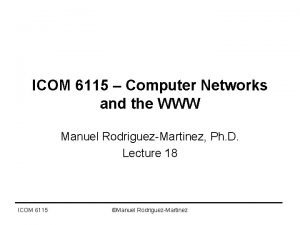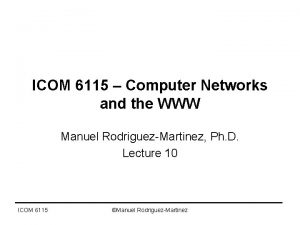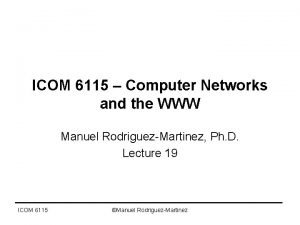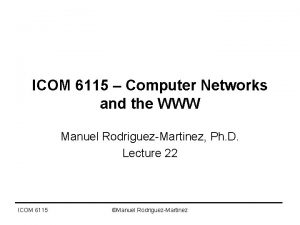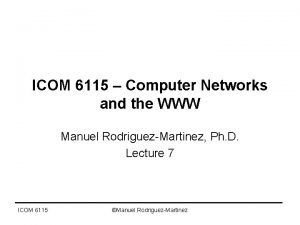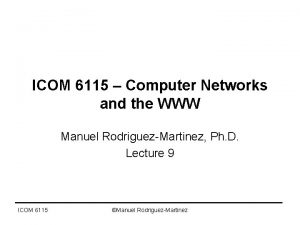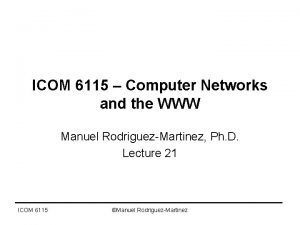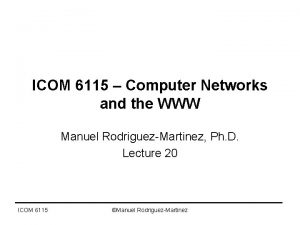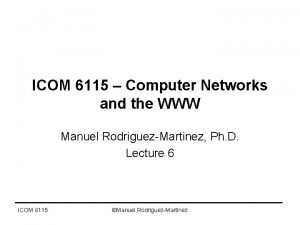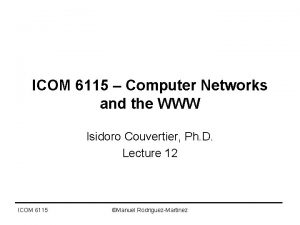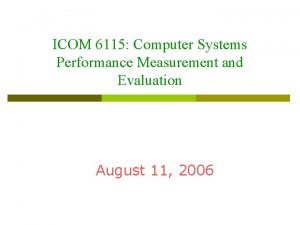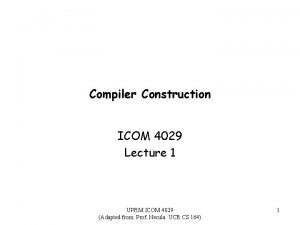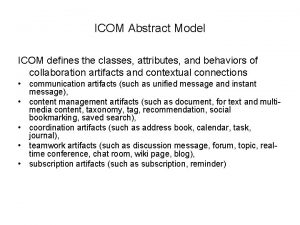ICOM 6115 Computer Networks and the WWW Manuel






















- Slides: 22

ICOM 6115 – Computer Networks and the WWW Manuel Rodriguez-Martinez, Ph. D. Lecture 26 ICOM 6115 ©Manuel Rodriguez-Martinez

Lecture Objectives • Introduction to Transport Layer – Layer 4 – User Datagram Protocol (UDP) – Transmission Control Protocol (TCP) ICOM 6115 ©Manuel Rodriguez-Martinez

Transport Layer • Provides reliable, cost-effective way to move data between two applications – independent of type of layer 3 • Application level API often interact with this module • Sockets are built on top of transport layer – TCP Sockets – UDP Sockets ICOM 6115 ©Manuel Rodriguez-Martinez

Layer 3, Layer 4 and Layer 5 Stack ICOM 6115 ©Manuel Rodriguez-Martinez

Transport services • Connectionless – Blocks of data sent over datagrams • Targeted for a specific process on a given machine • Connection-oriented – Reliable stream of bytes sent between two processes – Adds reliability to layer 3 • Transport entity – Module that uses the network layer to move data (inside OS of hosts) ICOM 6115 ©Manuel Rodriguez-Martinez

Typical Operations • LISTEN (usually server side) – Wait for a connection to occur • CONNECT (usually client side) – Request a connection to be established • SEND – Move some amount of data between processes • RECEIVE – Accepts some amount of data • DISCONNECT (bidirectional) – Terminate the connection ICOM 6115 ©Manuel Rodriguez-Martinez

Encapsulation at layer 4 • Data is packaged into TPDU – Transport Protocol Data Unit ICOM 6115 ©Manuel Rodriguez-Martinez

Typical State Transition Diagram ICOM 6115 ©Manuel Rodriguez-Martinez

Addressing • Transport layer identifies process by: – <Layer 3 Address, Port number> • Idea – Layer 3 Address identifies host on which process is running • Network Service Access Point (NSAP) • IP address – Port uniquely identifies a process on that host • Transport Services Access Point (TSAP) • Applications use to port to index data structure where data is placed – Send and receive operations ICOM 6115 ©Manuel Rodriguez-Martinez

Example of NSAPs and TSAPs ICOM 6115 ©Manuel Rodriguez-Martinez

Connection daemon ICOM 6115 ©Manuel Rodriguez-Martinez

Connection daemon • Connection daemon is used to spawn a new process to service a client request • Often used if we do not want to have a server running all the time on background – Ex. inetd can spawns telnet processes • OS must support way to pass variable – Pass context of process – UNIX • Fork() operation – Windows • Threads ICOM 6115 ©Manuel Rodriguez-Martinez

Demultiplexing data Process Port Message Queues Layer 4 Layer 3 ICOM 6115 ©Manuel Rodriguez-Martinez Process

User Datagram Protocol (UDP) • Provides a mechanism to send datagrams between processes – Blocks of data are sent • Just adds port information on top of IP packet – Can arrive delayed, out of order, or get lost • Unreliable services – Need to add ACKs if you want more • Some applications that use it – DNS (Domain Name Services) – NFS (Network File System) ICOM 6115 ©Manuel Rodriguez-Martinez

UDP Header ICOM 6115 ©Manuel Rodriguez-Martinez

Transmission Control Protocol (TCP) • Provides a reliable byte stream between processes • Data is guaranteed to – arrive safely – Be organized in the proper order and read in order • TCP streams provide the abstraction of a byte stream – Like a file ICOM 6115 ©Manuel Rodriguez-Martinez

TCP Byte Stream ICOM 6115 ©Manuel Rodriguez-Martinez

Buffering Data in TCP • Data is buffered until enough is present to be sent or read • Alternatively, the buffer can be flushed to force data out ICOM 6115 ©Manuel Rodriguez-Martinez

TCP Header ICOM 6115 ©Manuel Rodriguez-Martinez

TCP Three Way Handshake • Use to establish a connection • Client sends SYN message with a seq number x • Server replies with – SYN indicating its own sequence numbers y – ACK indicating it expects data with seq x + 1 • Client replies with ACK indicating it expects data with seq y + 1 • Sequence numbers address bytes! ICOM 6115 ©Manuel Rodriguez-Martinez

Timeline diagram ICOM 6115 ©Manuel Rodriguez-Martinez

Some Issues • Need to way for 3 -way handshake before sending data – How long is this? • This is bad for short live connection that send little data – HTPP request with small number of images ICOM 6115 ©Manuel Rodriguez-Martinez
 Virtual circuits and datagram networks
Virtual circuits and datagram networks Backbone networks in computer networks
Backbone networks in computer networks Yaesu ftm-400xdr vs icom 5100
Yaesu ftm-400xdr vs icom 5100 Papasys
Papasys Icom
Icom Icom
Icom Difference between intserv and diffserv
Difference between intserv and diffserv Error detection and correction in computer networks
Error detection and correction in computer networks Bit stuffing and byte stuffing in computer networks
Bit stuffing and byte stuffing in computer networks Character stuffing example
Character stuffing example What is the reverse request protocol
What is the reverse request protocol Analogue and digital transmission in computer networks
Analogue and digital transmission in computer networks Web and http in computer networks
Web and http in computer networks Computer networks and internets with internet applications
Computer networks and internets with internet applications Transmission error in computer networks
Transmission error in computer networks Protocols and standards in computer networks
Protocols and standards in computer networks Error detection and correction in computer networks
Error detection and correction in computer networks Computer networks and internets
Computer networks and internets Crc in computer networks
Crc in computer networks Crc in computer networks
Crc in computer networks Traffic management in computer networks
Traffic management in computer networks Tanenbaum
Tanenbaum What is optimality principle in computer networks
What is optimality principle in computer networks



